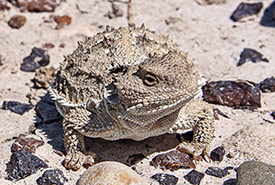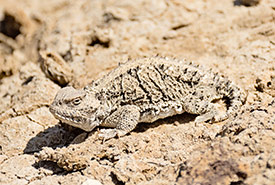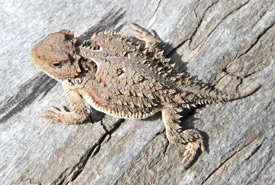Tales of recovery: Greater short-horned lizard

Greater short-horned lizard. (Photo by Leta Pezderic/NCC staff)
I’ve been lucky to have seen many reptiles that are at risk in Canada. I started my ecological career at Point Pelee National Park counting Blanding’s turtles and map turtles. I’ve seen queen snakes poke their heads through the surface of the Maitland River, and I have frozen my step upon hearing a rattle while hiking on the Prairies. But there’s one Canadian species that’s at the top on my reptile bucket list to still find: the greater short-horned lizard. Thanks to conservation efforts, I still have a chance.
Quick facts at a glance
Status in Canada
1970: presumed rare
2007: endangered
2018: special concernWhat worked?
Core population in protected areas, provincial regulations, diverse conservation approaches
The Canadian range of the greater short-horned lizard is limited to southern Alberta and Saskatchewan. It’s the only lizard found in these provinces. It belongs to a group of lizards sometimes referred to as horned toads, which is a decent description of what it looks like. If you ever see a lizard depicted in a western movie, it’s probably from this group. The only other horned lizard that occurred in Canada was the pygmy short-horned lizard, which was once found in south central BC’s Okanagan and Similkameen valleys. But it was last recorded back in 1957 and is now probably gone from Canada.
A species needing protection

Greater short-horned lizard. (Photo by Leta Pezderic/NCC staff)
Greater short-horned lizards have always had a restricted range in Canada, preferring dry, open sites with little vegetation and loose soils. This habitat is not suitable for farming, and this has helped to protect these lizards. Early Canadian naturalists knew they could be found in these scattered habitats, but not much else. But by the 1970s, as Canada began to cobble together early legislation on endangered species, the greater short-horned lizard was flagged as a species that probably needed protection.
Alberta led the way in protecting the greater short-horned lizard by including it on one of its first lists of endangered wildlife. In 1992, they were assessed as vulnerable by the Committee on the Status of Endangered Wildlife in Canada because of their restricted range. But by 2007, there was increasing concern for this lizard’s future. While the Saskatchewan population happened to fall within the boundary of Grasslands National Park, many of the sites in Alberta were threatened by rapidly expanding energy projects that could disturb their habitat. They had even disappeared from some sites. As a result, their status was upgraded to endangered.
Understanding how to protect the species
This status upgrade helped to support and spawn many conservation actions. Alberta had already approved the listing and protection of the greater short-horned lizard under the Alberta Wildlife Act. Any proposed development on public land required an impact assessment and mitigation, and several restrictions were put in place to protect the habitat of this endangered species. Many other recovery actions also occurred in the province to better understand and protect the greater short-horned lizard.
Alberta’s MULTISAR program provided information to landowners and conducted further inventories. Ten years ago, the Nature Conservancy of Canada secured a key property in the Pakowki Lake Natural Area that protects habitat for the greater short-horned lizard and a dozen other species at risk. This project was supported by the Government of Canada and the North American Waterfowl Management Plan.
These actions all supported the federal recovery strategy for the greater short-horned lizard that was released in 2015. In 2018, the greater short-horned lizard was reassessed as special concern; still a species at risk, but not in imminent risk of being lost from Canada.
Sharing the lessons learned

Greater short-horned lizard (Photo by Alan Schmierer)
Today, there is still a lot we need to learn about this species. Population estimates range somewhere between about 10,000 to 50,000. We need more information on its habitat and trends. The greater short-horned lizard and many other prairie species still have an uncertain future. Temperate grasslands, including Canada’s Prairies, are the least protected biome in the world. Prairie grasslands continue to be converted and lost, including areas in and around habitat for greater short-horned lizard. Even in protected areas, the quality of their habitat can be impacted by non-native invasive plants.
In a world that is rapidly losing biodiversity, the genuine improvement in the status of any wildlife species must be marked. The lessons learned in any recovery must be shared so that we can apply them to the hundreds of other Canadian species that also need our help.
The down-listing of the greater short-horned lizard from endangered to special concern highlights the importance of using diverse approaches to help protect species at risk. Strategically placed protected areas play a central role in conserving species with small ranges. If most of the greater short-horned lizard’s population was not inside Grasslands National Park and other areas managed for conservation, it would likely still be endangered. On public land, mapping critical habitat to manage land uses is essential. Private landowners on the Prairies are generally very supportive of protecting species at risk when provided with information, support and flexibility.
The greater short-horned lizard is a window into a future. When we protect key sites and manage species at risk in a manner that maintains their range, populations and number of locations, while reducing critical threats, they are less likely to warrant federal listing as threatened or endangered.
Recovering species at risk is a complex challenge. There is no single success formula, and the solutions will change depending on the time and place. As a result, our responses need to be dynamic and adaptive. As conservation practitioners we need to be prepared to test and to fail, but most importantly to share our results.
Resources
1. COSEWIC, COSEWIC status appraisal summary on the Pygmy Short-horned Lizard Phrynosoma douglasii in Canada. 2018, Committee on the Status of Endangered Wildlife in Canada: Ottawa. p. xiv.
2. Williams, M.Y., Notes on the vertebrates of the southern plains of Canada, 1923-1926. The Canadian Field-Naturalist, 1946. 60(3): p. 47-60.
3. Mosquin, T. and C. Suchal, Canada's threatened species and habitats. Canadian Nature Federation Special Publication, 1977. 6: p. 1-186.
4. Powell, G.L. and A.P. Russell, COSEWIC status report on the Greater Short-horned Lizard Phrynosoma hernandesi in Canada. 1992, Committee on the Status of Endangered Wildlife in Canada: Ottawa. p. 21.
5. COSEWIC, COSEWIC assessment and update status report on the Greater Short-horned Lizard Phrynosoma hernandesi in Canada. 2007, Committee on the Status of Endangered Wildlife in Canada: Ottawa. p. 41.
6. Environment Canada, Recovery Strategy for the Greater Short-horned Lizard (Phrynosoma hernandesi) in Canada. 2015, Environment Canada: Ottawa. p. v+45.
7. COSEWIC, COSEWIC assessment and status report on the Greater Short-horned Lizard Phrynosoma hernandesi in Canada. 2018, Committee on the Status of Endangered Wildlife in Canada: Ottawa. p. xi + 64.
8. Hoekstra, J.M., et al., Confronting a biome crisis: global disparities of habitat loss and protection. Ecology Letters, 2004. 8(1): p. 23-29.
9. Olive, A., Land, stewardship, and legitimacy: endangered species policy in Canada and the United States. 2014: University of Toronto Press.
10. Pittman, J., The struggle for local autonomy in biodiversity conservation governance. Journal of Environmental Planning and Management, 2019. 62(1): p. 172-188.


